Note
Click here to download the full example code
Maxwell filter data with movement compensation¶
Demonstrate movement compensation on simulated data. The simulated data contains bilateral activation of auditory cortices, repeated over 14 different head rotations (head center held fixed). See the following for details:
# Authors: Eric Larson <larson.eric.d@gmail.com>
#
# License: BSD (3-clause)
from os import path as op
import mne
from mne.preprocessing import maxwell_filter
print(__doc__)
data_path = op.join(mne.datasets.misc.data_path(verbose=True), 'movement')
head_pos = mne.chpi.read_head_pos(op.join(data_path, 'simulated_quats.pos'))
raw = mne.io.read_raw_fif(op.join(data_path, 'simulated_movement_raw.fif'))
raw_stat = mne.io.read_raw_fif(op.join(data_path,
'simulated_stationary_raw.fif'))
Out:
Opening raw data file /home/circleci/mne_data/MNE-misc-data/movement/simulated_movement_raw.fif...
Range : 25800 ... 34208 = 42.956 ... 56.955 secs
Ready.
Opening raw data file /home/circleci/mne_data/MNE-misc-data/movement/simulated_stationary_raw.fif...
Range : 25800 ... 34208 = 42.956 ... 56.955 secs
Ready.
Visualize the “subject” head movements. By providing the measurement information, the distance to the nearest sensor in each direction (e.g., left/right for the X direction, forward/backward for Y) can be shown in blue, and the destination (if given) shown in red.
mne.viz.plot_head_positions(
head_pos, mode='traces', destination=raw.info['dev_head_t'], info=raw.info)
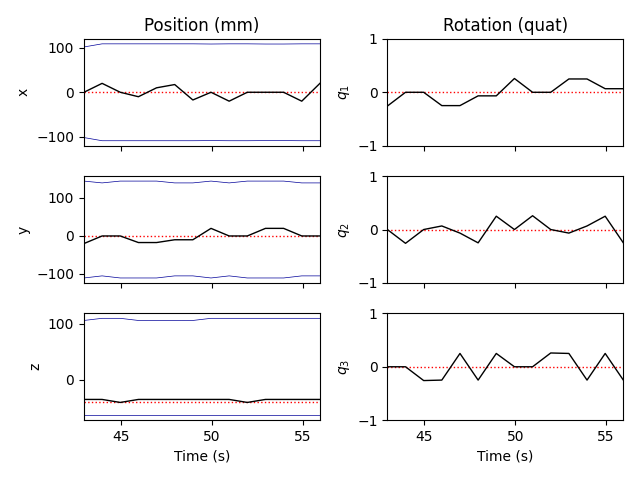
This can also be visualized using a quiver.
mne.viz.plot_head_positions(
head_pos, mode='field', destination=raw.info['dev_head_t'], info=raw.info)
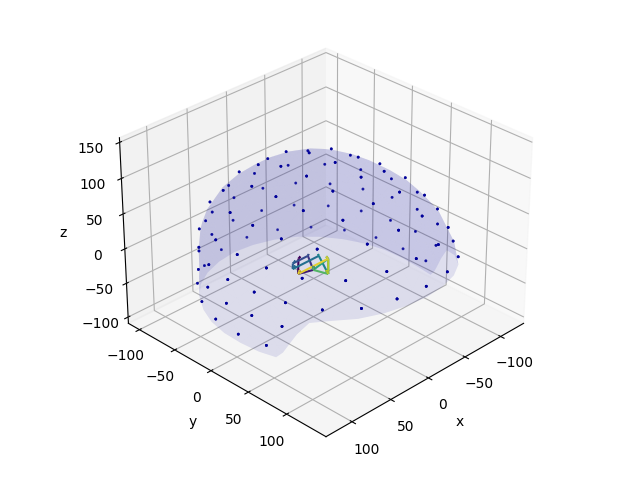
Out:
Getting helmet for system 306m
Process our simulated raw data (taking into account head movements).
# extract our resulting events
events = mne.find_events(raw, stim_channel='STI 014')
events[:, 2] = 1
raw.plot(events=events)
topo_kwargs = dict(times=[0, 0.1, 0.2], ch_type='mag', vmin=-500, vmax=500,
time_unit='s')
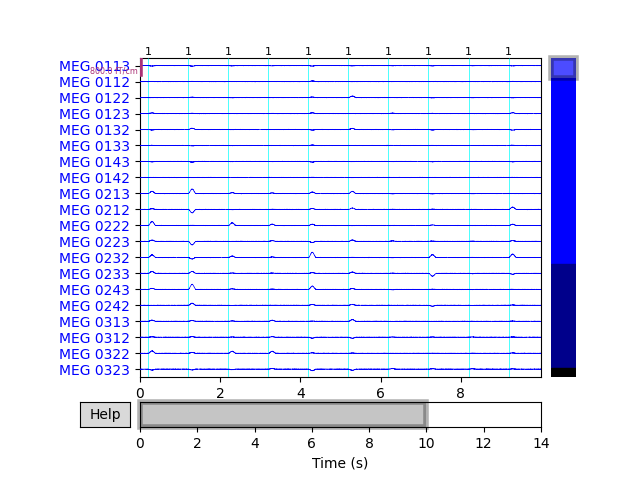
Out:
14 events found
Event IDs: [ 1 2 3 4 5 6 7 8 9 10 11 12 13 14]
First, take the average of stationary data (bilateral auditory patterns).
evoked_stat = mne.Epochs(raw_stat, events, 1, -0.2, 0.8).average()
evoked_stat.plot_topomap(title='Stationary', **topo_kwargs)
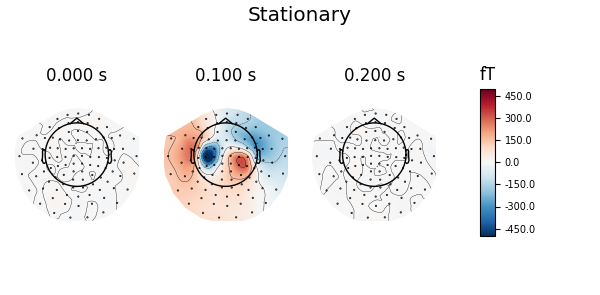
Out:
Not setting metadata
Not setting metadata
14 matching events found
Setting baseline interval to [-0.19979521315838786, 0.0] sec
Applying baseline correction (mode: mean)
0 projection items activated
Second, take a naive average, which averages across epochs that have been simulated to have different head positions and orientations, thereby spatially smearing the activity.
epochs = mne.Epochs(raw, events, 1, -0.2, 0.8)
evoked = epochs.average()
evoked.plot_topomap(title='Moving: naive average', **topo_kwargs)
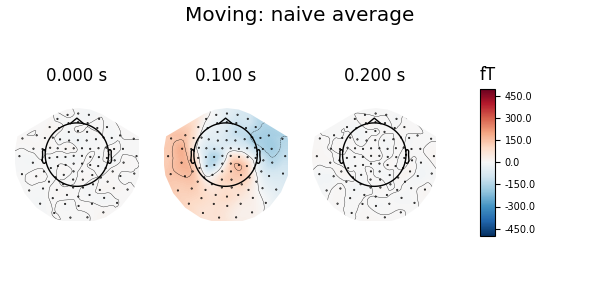
Out:
Not setting metadata
Not setting metadata
14 matching events found
Setting baseline interval to [-0.19979521315838786, 0.0] sec
Applying baseline correction (mode: mean)
0 projection items activated
Third, use raw movement compensation (restores pattern).
raw_sss = maxwell_filter(raw, head_pos=head_pos)
evoked_raw_mc = mne.Epochs(raw_sss, events, 1, -0.2, 0.8).average()
evoked_raw_mc.plot_topomap(title='Moving: movement compensated (raw)',
**topo_kwargs)
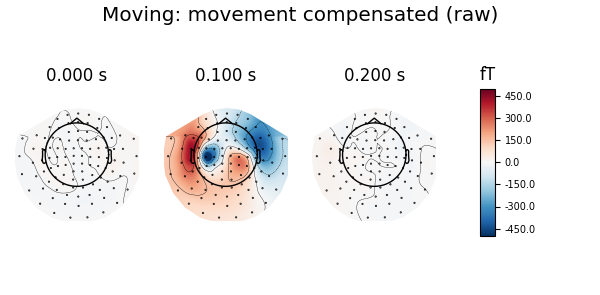
Out:
Maxwell filtering raw data
No bad MEG channels
Processing 203 gradiometers and 102 magnetometers
Automatic origin fit: head of radius 91.0 mm
Using origin -4.1, 16.0, 51.7 mm in the head frame
Using 90/95 harmonic components for 0.000 (75/80 in, 15/15 out)
Appending head position result channels and loading raw data from disk
Processing 1 data chunk
Using 87/95 harmonic components for 0.000 (72/80 in, 15/15 out)
Using 88/95 harmonic components for 1.001 (73/80 in, 15/15 out)
Using 90/95 harmonic components for 2.000 (75/80 in, 15/15 out)
Using 88/95 harmonic components for 3.000 (73/80 in, 15/15 out)
Using 88/95 harmonic components for 3.999 (73/80 in, 15/15 out)
Using 88/95 harmonic components for 5.000 (73/80 in, 15/15 out)
Using 89/95 harmonic components for 6.001 (74/80 in, 15/15 out)
Using 93/95 harmonic components for 6.999 (78/80 in, 15/15 out)
Using 88/95 harmonic components for 8.000 (73/80 in, 15/15 out)
Using 91/95 harmonic components for 9.001 (76/80 in, 15/15 out)
Using 93/95 harmonic components for 10.000 (78/80 in, 15/15 out)
Using 93/95 harmonic components for 11.000 (78/80 in, 15/15 out)
Using 89/95 harmonic components for 11.999 (74/80 in, 15/15 out)
Using 88/95 harmonic components for 13.000 (73/80 in, 15/15 out)
Used 14 head positions for 0.000 - 13.999 sec (#1/1)
[done]
Not setting metadata
Not setting metadata
14 matching events found
Setting baseline interval to [-0.19979521315838786, 0.0] sec
Applying baseline correction (mode: mean)
0 projection items activated
Fourth, use evoked movement compensation. For these data, which contain very large rotations, it does not as cleanly restore the pattern.
evoked_evo_mc = mne.epochs.average_movements(epochs, head_pos=head_pos)
evoked_evo_mc.plot_topomap(title='Moving: movement compensated (evoked)',
**topo_kwargs)
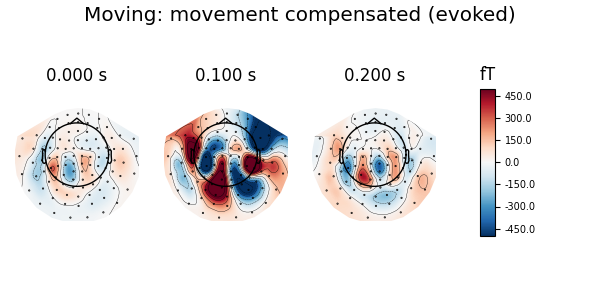
Out:
Automatic origin fit: head of radius 91.0 mm
Aligning and averaging up to 14 epochs
No bad MEG channels
Processing 203 gradiometers and 102 magnetometers
Processing epoch 1 (device location: 0.0, 0.0, 40.0 mm)
Processing epoch 2 (device location: 0.0, 0.0, 40.0 mm)
Processing epoch 3 (device location: 0.0, 0.0, 40.0 mm)
Processing epoch 4 (device location: 0.0, 0.0, 40.0 mm)
Processing epoch 5 (device location: 0.0, 0.0, 40.0 mm)
Processing epoch 6 (device location: 0.0, 0.0, 40.0 mm)
Processing epoch 7 (device location: 0.0, 0.0, 40.0 mm)
Processing epoch 8 (device location: 0.0, 0.0, 40.0 mm)
Processing epoch 9 (device location: 0.0, 0.0, 40.0 mm)
Processing epoch 10 (device location: 0.0, 0.0, 40.0 mm)
Processing epoch 11 (device location: 0.0, 0.0, 40.0 mm)
Processing epoch 12 (device location: 0.0, 0.0, 40.0 mm)
Processing epoch 13 (device location: 0.0, 0.0, 40.0 mm)
Processing epoch 14 (device location: 0.0, 0.0, 40.0 mm)
Created Evoked dataset from 14 epochs
Total running time of the script: ( 0 minutes 18.830 seconds)
Estimated memory usage: 8 MB